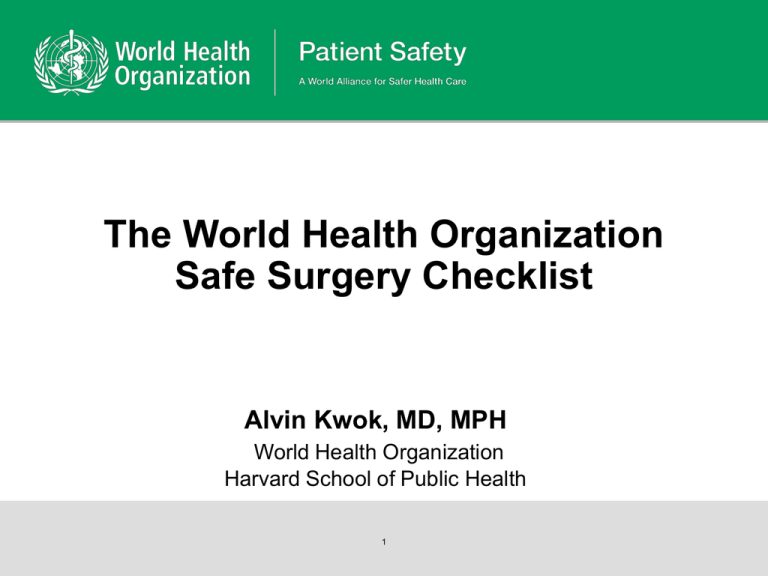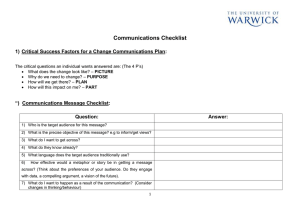
The World Health Organization
Safe Surgery Checklist
Alvin Kwok, MD, MPH
World Health Organization
Harvard School of Public Health
1
• Surgery is a public health issue
• 234 million surgical procedures per year
Outnumbers childbirth and HIV
• Surgery is associated with considerable risk of
complications and death
■ At least 7 million disabling complications worldwide each year
■ At least 1 million deaths worldwide each year
2
• Preventable complications:
■ There are between 1500 and 2500 wrong site surgery
incidents every year in the US ¹
■ An analysis of 1256 incidents involving general anaesthesia
in Australia showed that pulse oximetry on its own would
have detected 82% of them 2
■ Giving antibiotics within one hour before incision can cut the
risk of surgical site infection by 50% 3,4
3
¹ Seiden, Archives of Surgery, 2006.
2 Webb, Anaesthesia and Intensive Care, 1993.
3 Bratzler, The American Journal of Surgery, 2005.
4 Classen, New England Journal of Medicine,1992.
Reality Check:
Currently, hospitals do MOST of the right
things, on MOST patients, MOST of the
time.
The Checklist helps us do ALL the
right things, on ALL patients, ALL the
time
4
Outline
• Surgical Safety Checklist Pilot Study (NEJM 2009)
• Surgical Safety Checklist and Pulse Oximetry Pilot Study
5
Surgical Safety Checklist
© World Health Organization (WHO). All rights reserved. This content is excluded from
our Creative Commons license. For more information, see http://ocw.mit.edu/fairuse.
6
The Checklist was piloted in 8 cities…
Toronto, Canada
Lodon, UK
New Delhi, India
Manila, Philippines
Seattle, USA
Amman, Jordan
Ifakara, Tanzania
Auckland, NZ
Image by MIT OpenCourseWare.
7
...and was found to reduce the rate of
postoperative complications and
death by more than one-third!
8
Results:
All sites
Baseline
Checklist
Cases
3733
3955
-
Death
1.5%
0.8%
0.003
Any
Complication
11.0%
7.0%
<0.001
Surgical Site
Infection
6.2%
3.4%
<0.001
Unplanned
Reoperation
2.4%
1.8%
0.047
Haynes et al. A Surgical Safety Checklist to Reduce Morbidity and Mortality in a Global
Population. New England Journal of Medicine 360:491-9. (2009)
9
P value
Change in Death and Complications
by Income Classification
Haynes et al.
A Surgical Safety Checklist to
Reduce Morbidity and Mortality
in a Global Population.
New England Journal of
Medicine 360:491-9. (2009)
High
Income
Change in
Complications
Change in
Death
10.3% -> 7.1%*
0.9% -> 0.6%
Low and 11.7% -> 6.8%*
Middle
Income
* p<0.05
10
2.1% -> 1.0%*
Surgical Safety Checklist Worldwide
© World Health Organization (WHO). All rights reserved. This content is excluded from
our Creative Commons license. For more information, see http://ocw.mit.edu/fairuse.
11
© World Health Organization (WHO). All rights reserved. This content is excluded from
our Creative Commons license. For more information, see http://ocw.mit.edu/fairuse.
12
Image courtesy of The Neenan Company on Flickr.
13
14
Pulse Oximetry
■ Standard of safe anaesthesia and surgery
■ High-income countries
■ Present in virtually all operating rooms
■ Low-income countries
■ Absent from >50% of operating rooms
15
Funk et al Lancet 2010
Surgical Safety Checklist and Pulse Oximetry
Pilot Study
• Aim #1: To pilot study the effect of checklist
and pulse oximetry implementation on
mortality
• Aim #2: To measure the effects of pulse
oximetry training by monitoring hypoxemia
rates during surgery
16
Three pilot sites…
Toronto, Canada
Chisinau, Moldova
Lodon, UK
New Delhi, India
Manila, Philippines
Seattle, USA
Amman, Jordan
San Pedro Sula,
Honduras
Ifakara, Tanzania
Lusaka, Zambia
Auckland, NZ
Image by MIT OpenCourseWare.
17
Implementation/Intervention Plan
WHO, HSPH, WFSA
(oversight)
Principles:
1. Implementation Team
2. Lecture
3. Demonstration
4. Role-Play
5. Coaching with Feedback
Local Implementation Team
(Anesthesiologist, Surgeon, Nurse)
• Lecture
• Demonstration
• Role-Play
• Coaching with
Feedback
Operating Room Staff
18
CHANGE
Data Collection
Local Hospital Administration
19
20
- Using the Checklist we can save lives
and prevent complications
- Pulse oximetry is an essential part of
safe surgery
- Implementation of the Checklist and Pulse
Oximetry can improve surgical outcomes
- Implementation of the Checklist and Pulse
Oximetry can improve surgical outcomes
around the world
21
The World Health Organization
Safe Childbirth Checklist Program
Priya Agrawal, MD MPH
World Health Organization
Harvard School of Public Health
22
Image courtesy of The Neenan Company on Flickr.
23
Checklist
Development
Assemble evidence on possible areas of
improvement and critical omissions
Identify pause points &
Draft Checklist Items
Checklist
Evaluation
Experts/field users review draft checklist
PILOT
STUDY
RCT
1st validation stage – Can it change
improve quality/safety of care?
2nd validation stage – Does it reduce
mortality and morbidity?
24
Dissemination
Redraft
checklist
Problems
The magical ingredient?
25
© World Health Organization (WHO). All rights reserved. This content is excluded from
our Creative Commons license. For more information, see http://ocw.mit.edu/fairuse.
Safer Childbirth
130 Million Births worldwide each year
350,000 Maternal Deaths
Infection
Hemorrhage
Hypertensive disorders
Prolonged/obstructed labor
4 Million Neonatal Deaths
(3 million Early Neonatal Deaths)
Infection
Asphyxia
Prematurity
3.3 Million Stillbirths
(1 million intrapartum-related)
26
Poor intrapartum fetal monitoring
Poor neonatal resuscitation
Different challenge, similar solution
• 99% of burden is in resource-poor settings
• Extremely variable level of training of caregiver
• High-risk period could cover days, rooms, caregivers,
facilities
• No obvious team structure
• Woman is awake and ‘well’
• Rich evidence-base available and proven
interventions are inexpensive
27
Sources Informing Checklist Content
• WHO published guidelines
• Evidence-based literature
• Expert consensus
• Collaborator feedback
• Mortality and near-miss audits
28
Pause Points
Pause point #2
Just before pushing
(or before
Cesarean)
Pause point #1
Maternal & neonatal mortality risk
On admission
Pause point #3
Soon after
birth
(within 1 hour)
Pause point #4
Before
Discharge
Delivery
Postpartum
Labor progression
Discharge from birth facility
Admission to birth facility
Labor onset
Antenatal period
28 days
Conception
42 days
Pre-conception
Time
29
Program Progress
Review evidence – Starting Oct 2008
International Consultation – July 2009
Development of Safe Childbirth Checklist draft content
Expert Panel Meeting #1 – Nov 2009
“Usability Feedback Cycle” Field Development & Checklist Modification
Expert Panel Meeting #2 – May 2010
30
WHO Partners
Patient Safety: Gerald Dziekan, Angela Lashoher, Claire Lemer
Child & Adolescent Health: Rajiv Bahl, Wilson Were
Making Pregnancy Safer: Matthews Mathai, Severin Ritter von Xylander, Jelka Zupan
Reproductive Health & Research: Mario Merialdi
Expert Collaborators
Sabaratnam Arulkumaran, Mohamed Bassiouny, Kate Beaumont, Staffan Bergstrom,
Shereen Bhutta, Zulfiqar Bhutta, Ann Blanc, Flavia Bustreo, Oona Campbell, Waldemar Carlo,
Meena Cherian, Jo Cox, Susan Crowther, Gary Darmstadt, Louise Day, Jot Dhadialla, Mark
Dybul, Barbara Farlow, Lynn Freedman, Zhao Gengli, Wendy Graham, Kathleen Hill,
Justus Hofmeyr, Julia Hussein, AK Jana, Cate Kamau, Unni Karunakara, Khalid Khan,
Grace Kodindo, BS Kodkany, Uma Kotagel, Barbara Kwast, Tina Lavender, Joy Lawn,
Gwyneth Lewis, Sompop Limpongsanurak, Bridget Lynch, Deborah Maine, Rose Malay,
Rashad Massoud, Alex Matthews, Colin McCord, Claudia Morrissey, Nester Moyo,
Margaret Nakakeeto, Susan Neirmeyer, Padmanaban Packirisamy, Naren Patel,
Robert Pattinson, Vinod Paul, Craig Rubens, Harshad Sanghvi, Harshalal Seneviratne,
Susan Sheridan, Sara Stulac, Youssef Tawfik, Nynke van den Broek, Claudia Vera, Phommady
Vesaphong, Jean-José Wolomby, David Woods, Linda Wright, Blair Wylie, Juliana Yartey
31
32
AFGHANISTAN
Jammu &
Kashmir
CHINA
Himachal
Pradesh
Punjab
Uttaranchal
Haryana
PAKISTAN
CH
Delhi
IN
A(
Tib
et)
NEP
AL Sikkim
Arunachal
Pradesh
BHUTAN
Assam Nagaland
Uttar Pradesh
Meghalaya
Bihar
Manipur
BANGLADESH
Jharkhand
Tripura Mizoram
West
Madhya Pradesh
Bengal Kolkata
Chattisgarh
MYANMAR
Rajasthan
Gujrat
Orissa
Maharashtra
Mumbai
Bay of Bengal
Arabian Sea
Andra Pradesh
Goa
Karnataka
Chennai
LAKSHADWEEP
ISLANDS
Pondicherry
Kerala
ANDAMAN
ISLANDS
Tamil Nadu
Andaman Sea
NICOBAR
ISLANDS
33
Safe Childbirth Checklist Program
Image by MIT OpenCourseWare.
Pilot Study - Objectives
1.Measure healthcare worker performance: effective
delivery of essential standards of care proven to result in
improved maternal, fetal, and neonatal health outcomes
2.Obtain qualitative feedback describing contextual
factors that facilitate or block successful checklist
implementation
3.Measure trends in mortality and major morbidity rates
after checklist implementation
34
Pilot Study - Design
Pre-Intervention
~3 months
300 Patients
Intervention
1 week
Post-Intervention
~3 months
300 Patients
Checklist Training
and
Implementation
Childbirth Improvement Coordinator meets with childbirth staff
1.Stories shared
2.Some baseline data shared
3.Checklist content modified to fit local practice
4.Instructional video and simulation practice
5.Supervised practice, feedback, ongoing support
Safe
Childbirth
Checklist
SAFER
CHILDBIRTH
35
Safety
Rounds
Childbirth
Improvement
Coordinator
Results
• ALL of the 29 essential standards of care were delivered
more reliably
• Overall effective delivery of a core set of standards
improved by over 50%
• System changes catalyzed by introduction of checklist
• Job satisfaction and patient satisfaction increased
• Better teamwork and communication
36
Next steps
RCT
Implementation
Use of technology?
37
Thank-you!
Questions?
38
MIT OpenCourseWare
http://ocw.mit.edu
HST.S14 Health Information Systems to Improve Quality of Care in Resource-Poor Settings
Spring 2012
For information about citing these materials or our Terms of Use, visit: http://ocw.mit.edu/terms.


